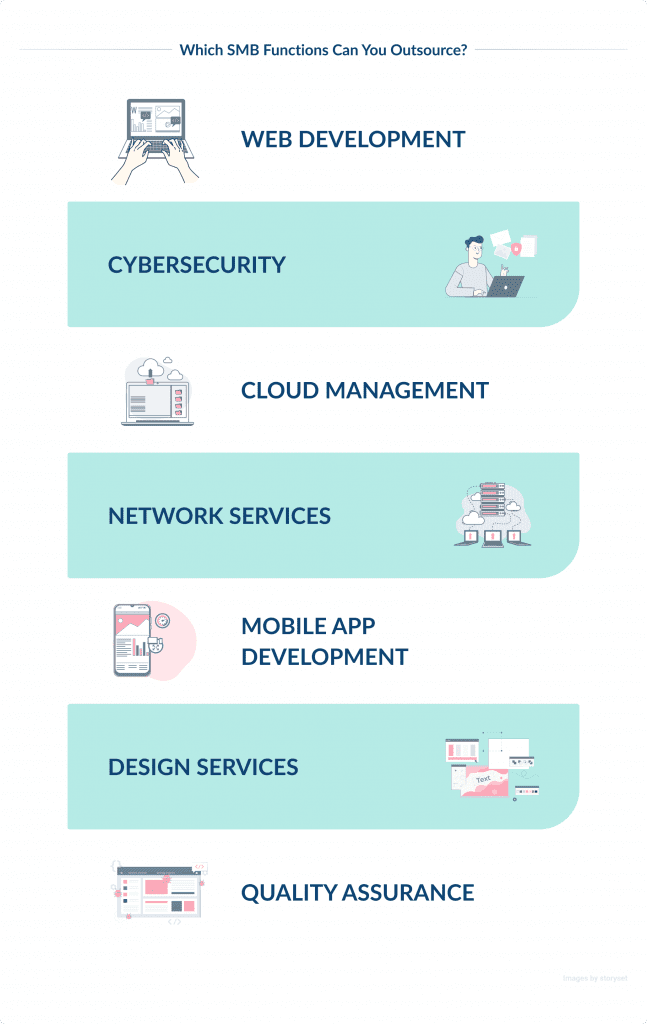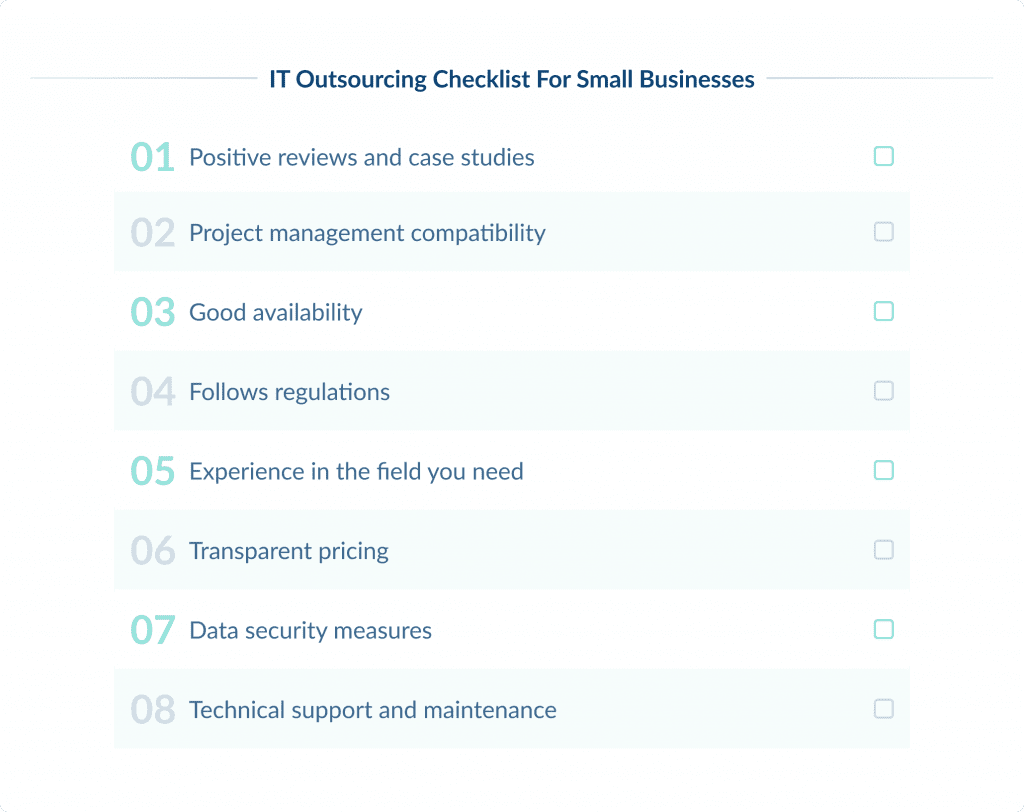Small Business IT Outsourcing: Everything You Need to Know
- Updated: Nov 08, 2024
- 7 min
As a small business owner, lowering overheads is critical to success. But you also need an expert IT team to stay competitive.
So, how can you reduce costs and still enjoy the benefits of a highly professional IT team?
Outsourcing is the solution. It gives you access to the tech specialists you need without the strain of full-time employees. It’s a shortcut to maximizing expertise within your budget.
Before diving into the topic, feel free to discover the benefits of IT outsourcing and why it’s popular for scaling tech needs.
What is IT Outsourcing?
IT outsourcing is the process of contracting an external team of IT specialists to complete projects rather than hiring a team in-house. Businesses often maintain some full-time staff while employing external teams for specific tasks.
As a small business, you can outsource MVP development service to fund your project or dedicate mobile app development to professionals. Let’s see what other IT tasks you can outsource.
Which SMB Functions Can You Outsource?
SMBs (small and medium businesses) typically outsource temporary or fluctuating jobs. Often, they contract a team of specialists, for instance, dedicated mobile app developers, to complete a specific project that requires expertise they lack.
An enterprise may also “outstaff” a team for long-term collaborations. Outstaffing is hiring external specialists to work alongside you as needed for an undefined period.
IT outsourcing for small businesses can include many IT tasks, such as:
- Web development
- Cloud application development services
- Mobile app development
- Design Services
- QA Testers Services

When It’s Time to Outsource (and When It’s Not)
Deciding whether IT outsourcing is right for you is challenging. Consider the following questions:
- Can my current team handle the tasks I need?
Start by defining the exact projects you need a team to complete. Then, identify whether your current employees have the skills to take them on. If the tasks will overpressure your team, it’s better to outsource.
- Do I need these staff full-time, year-round?
You can work with outsourcing agencies, like SPDLoad, on a long-term basis. Lots of our clients prefer this type of cooperation. They say it helps them save time and money on recruitment procedures and allows them to focus on their key tasks while we handle the tech part.
- Do you have time to assemble an in-house team?
Outsourcing gives you access to a ready-to-go team without hassle. Consider whether you can stay competitive despite hiring and onboarding processes.
Making the right choice is crucial. Here’s everything you need to know about in-house development vs. outsourcing.
- Is outsourcing cost-effective?
Your bottom line is your key consideration. Outsourcing should offer a positive return on investment.
If you’re unsure whether to involve third-party specialists, start small. Outsource a simple task and analyze the project’s progress.
Top 7 Benefits of IT Outsourcing for Small Businesses
Research from Statista shows that the market size for IT outsourcing will almost double by 2028. Let’s investigate why a growing number of businesses are choosing to outsource. 
Reduced Costs
38% of small businesses that fail do so because they run out of funds. Outsourcing helps you stay profitable by reducing or eliminating the need for in-house staff, training programs, and specialized software.
In addition, outsourcing gives you easy access to global teams. Employing external IT teams in areas with lower costs of living allows you to pay lower rates for experts.
Increased Scalability
Getting your business up and running is challenging. Once you’re enjoying positive momentum, you must have the necessary tools to make the most of it.
Outsourcing gives you a team that’s ready to grow with your business. As soon as you identify new market opportunities, you can request extra assistance from your external team. This allows you to adapt to consumer demand quickly.
For example, suppose you’re looking to develop a marketplace. In that case, an external team can quickly take over the technical parts of development and design, helping you to deliver a product before competitors.
Specialist Expertise
Collaborating with a dedicated development team as a small business gives you access to professionals who follow best practices and adhere to regulations.
While expertise is essential, you will also access their high-quality hardware, software, servers, and routers. This means you don’t need to spend on expensive tech.
Get a strategic MVP to mitigate risks.
Shortcut The Recruitment Process
There are two key challenges for SMBs hiring in-house IT staff: acquisition and retention.
The first hurdle is hiring employees with the skills and experience you need. In fact, 63% of businesses find it hard to secure IT talent. On top of that, each new hire costs an average of $4,683.
With such a high cost per hire, you’d hope those employees stay long-term. Yet the turnover rate for tech staff is at 10.6%. By IT outsourcing, small businesses avoid these costs and concerns.
Takeover High-Priority Tasks
Outsourcing lets you delegate critical IT operations, such as cybersecurity monitoring, data backup, software testing, and QA, to experts.
If you run a small business, outsource IT teams with a wealth of experience delivering similar projects to similar businesses. This experience will reduce risks and allow you to focus on the most important business tasks.
Flexibility
Hiring an IT team in-house is like keeping the heating on full blast year-round. Even on the hottest days, it’s firing up. Sounds uncomfortable, right? Having an outsourced team works like a thermostat. You dial it down during the quiet months, but when you need it – it’s there.
Whether undertaking a new project like website development or managing fluctuating IT tasks, an outsourced team will work to your requirements. Outsourcing gives you maximum flexibility to scale up or down IT resources based on demand.
This will help keep your business competitive by reducing costs and increasing growth opportunities.
If you’re developing a site, here’s the average time to create a website for each phase of the process.
Fewer Regulations
Complying with regulations and standards is complex and demanding. Outsourcing shifts the burden of responsibility to your external team.
They will undertake the difficult task of staying up-to-date with regulatory changes and ensuring that data handling, privacy practices, and cybersecurity measures comply with laws and industry standards.
Learn about the most impactful cybersecurity trends to safeguard sensitive data and prevent breaches.
An established outsourcing team will have a strong security posture that you can access right away, ensuring you avoid penalties.
Learn about effective bot attack prevention strategies to safeguard your site and data.
Potential Challenges and How to Overcome Them
While outsourcing enriches your business with a flexible, pre-vetted team, challenges can still arise. Let’s examine the most common pitfalls and how to avoid them.
Lack of Control
When outsourcing, you’re putting your trust in a business outside of your organization. While this strengthens your overall expertise, you may be concerned by the lack of direct oversight.
You may struggle to manage differences in working styles, priorities, or simply the culture between you and your outsourced team.
What’s the solution?
Work closely with your outsourced team to define projects. Project management tools can be helpful here. They make it easy to keep track of progress and agree on clear, measurable goals. Building a relationship based on trust and transparency can help you maintain control.
For efficient task handling, here are the best project management software options available today.
Communication Issues
Effective communication is vital for the health of any relationship, and outsourcing is no different. Working with an external team who communicates poorly can feel frustrating. It may result in unnecessary back-and-forths or your external team incorrectly completing projects.
What’s the solution?
Choose an outsourcing partner with a strong track record of excellent communication. Ensure the external team has a good command of the language you primarily use. Take advantage of the many tools available, such as video calls, instant messaging, and project management platforms that encourage quick, clear communication.
Quality Issues
While the IT staff you outsource aren’t working within your business, their work will represent your business.
That’s why you must ensure the team you hire will create quality IT systems that function long-term. Picking the wrong team to work with, just like hiring the wrong staff member, can leave you with disappointing results.
What’s the solution?
Hire developers for startup carefully!
Ensure they have positive reviews, certifications, and quality assurances that align with your expectations. Before you start, make a list of the deliverables and put them in the contract.
As the project progresses, conduct regular quality checks and provide feedback after completing each stage. Alternatively, consider a trial project to evaluate the outsourcing team’s capabilities before committing to a larger project.
We are your reliable white-label companion for design and development services.
How to Choose the Right Small Business IT Outsourcing Partner
While there isn’t a one-size-fits-all model for outsourcing, there are some key considerations that will help you pick the best team for your business. Ask yourself the following questions before choosing a team:
- What are the projects I need to complete? Clearly identify the IT requirements your business has. Create an outline of the work you need completed alongside a realistic timeframe.
- How do I like to work? Consider the project management apps you prefer to work on. Assess whether you prefer collaborating in sprints or using a traditional waterfall method for complete projects.
- How do I like to communicate? Decide whether you like to communicate through video calls, WhatsApp, or email. Identify how often you would ideally check in with your outsourced team.
- Can I trust this business? Ensure the business is well-reviewed, trustworthy, and secure. Trust is crucial for fruitful collaboration. And in the case of our collaboration with Blue Academy, it was a decisive factor for them. Personal trust, experience, and competency were the key requirements from the client’s side, and we matched them perfectly.
- Can they grow with me? Check availability and case studies to ensure your outsourced team is prepared to meet the needs of your expected growth.
Here’s a ready-to-go checklist for IT outsourcing. Small businesses should ensure their external IT team has the following: 
How to Outsource IT for Small Businesses?
Outsourcing frees you to grow your business flexibly. It protects your business by letting you avoid unnecessary costs and the drawn-out hiring process.
While the upsides are clear, you must assess the outsourcing company to ensure they offer a quality team that’s compatible with your communication and project management systems.
Ready to start saving money and growing your business?
Contact us to launch a collaboration.
Want to improve your healthcare IT infrastructure? Learn the benefits of healthcare IT outsourcing in this comprehensive guide.












